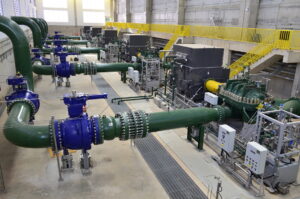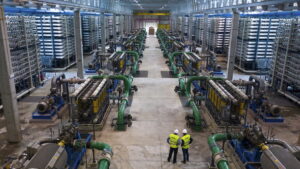Making clean, safe drinking water widely available is one of human society’s greatest priorities. 90 % of the world’s population currently has access to at least a basic source of potable water, and 71 % of people enjoy a managed supply of clean water to their homes (1). With the aim to further increase availability while controlling costs, utilities are continually investing to expand, upgrade and improve their networks, operations and maintenance processes. Antonio De La Torre, Business Development Manager Clean Water at Sulzer, looks at how innovative technology can be used to improve water supplies.

Reliable water supplies are often taken for granted. This is highlighted by significant disruptions of more than a few hours being noteworthy enough to receive widespread media coverage. Anyone connected to the industry is well aware, however, that reliable, high quality potable water supplies require plenty of effort behind the scenes. In the coming decades, the tasks of upgrading networks and improving supplies are likely to become even more challenging. Overall water demand has been rising at around 1 % a year since the 1980s, driven by population growth and increasing standards of living.
That trend is expected to continue, resulting in a 30% rise in demand by the middle of this century (2). Increasing urbanization, meanwhile, will lead to much higher needs in fast-growing cities and towns. Meeting that demand is placing greater pressure on the supply side, stretching the capacity of water treatment and storage infrastructure while driving regions to identify new water sources.
Cost, quality and reliability
In addition to the supply/demand challenge, water companies also know that they have an important role to play in the long-term protection of the environment. That requires steps to minimize the consumption of energy and materials, as well as reducing the impact of chemicals and waste streams.

The move to globally aligned water quality standards is sharpening the focus on treatment effectiveness and strong process control. Companies also need to achieve all these things while maintaining strict financial discipline, with the aim of making potable water as inexpensive as possible for consumers. Meeting these complex, and sometimes conflicting, requirements is a significant technical and business challenge. It requires water industry players to continually explore innovative new approaches, refine proven technologies and work collaboratively with contractors as well as equipment providers to develop robust, cost-effective and flexible solutions.
Engineering enhancement
Sulzer has been involved in the clean water infrastructure sector for decades. Water companies use its water pumping and treatment solutions as well as its engineering expertise on projects of all kinds, from local refurbishment and upgrades to the largest and most innovative new infrastructure investments.
In Brazil, the company has delivered five of the largest pumps to be installed in the country as part of a new water supply system that delivers up to 6’400 liters of drinking water per second to residents. Water is pumped from a reservoir to the treatment plant 83 km away and 365 meters higher in elevation. Sulzer’s pumps use a 970 mm diameter, high-efficiency two-stage impeller to deliver the large volumes of water, which will be sufficient to meet the projected demand for the next 10 years.

In contrast, Sulzer has also been involved in unique projects that demand specialist design and manufacturing skills. In New Orleans, the company needed to supply three custom pumps capable of operating on the local 25 Hz electrical supply. At the same time, equipment dimensions were required to be small enough to fit in the existing historical building’s main entrance door.
Desalination innovation
One area of particularly active development in regions facing high levels of water stress is the construction of large-scale desalination plants using reverse osmosis (RO) technology. This has transformed the economics of desalination over recent years, halving the cost of producing clean, potable water from seawater.
While advances in membrane performance and energy recovery have been central to these improvements, the efficiency of modern RO plants is highly dependent on their pumps. Capital Expenditure in pumps represents about 3 % to 5 % of total RO plant investment. However, the energy consumed by them accounts for 60 % to 70 % of the Operational Expenditure of the water produced by such a plant. Thus, taking into account the pump operational parameters as well as its design when creating the complete plant is crucial to achieving the lowest possible cost of the water. Along the years, Sulzer has been committed to working with its customers to deliver the most efficient and reliable solutions. The company was pioneering in its support of the Pressure Center Concept plants, supplying larger high-pressure pumps that had never been used at that time for such applications. This continued with the introduction of highly efficient and cost-effective end suction pumps for larger capacities, as well as the configured, product lubricated, ring section multistage high-pressure pumps. More recently, Sulzer brought the pressure center concept one step further with even larger high-pressure pumps that delivered never before seen efficiency ratings.
Examples of these can be seen recently in the Kingdom of Saudi Arabia, where Sulzer pumps have been selected for the SWCC West Coast project, which involves the construction of eight new mid-size RO facilities across the region and for the larger SWPC Shuqaiq 3 plant. Today, Sulzer is proud that its installed base is supporting the efficient production of more than 20 million of cubic meters per day of desalinated water.
New challenges
Today, society is not only facing water scarcity, which can be alleviated by desalination, but also the challenge of improving water reuse. This is elevated by new regulations for health and sanitation as well as the introduction of drinking water certification. Modern, industrialized societies are introducing new pollutants, such as chemical and pharmaceutical components as well as micro plastics, which require innovative treatment processes to remove them.
The recent addition of Nordic Water to the Sulzer family has provided significant additional expertise in the design and manufacture of filtration, sedimentation and other process systems. In particular, the company’s renowned water treatment products like continuous sand filters, lamella plate settlers and scrapers. These provide compelling offerings for customers seeking to improve the sustainability of their water treatment infrastructure, by using more biological processes, minimizing chemical consumption, increasing capacity and reducing the footprint of equipment. The world’s water industry is pursuing an extraordinary range of approaches to meet the challenges of the 21st century. Sulzer’s equipment, technology and engineering expertise is playing a key part in the industry’s continual evolution.
Sources
- (1) WHO www.who.int/news-room/fact-sheets/detail/drinking-water
- (2) UN World Water Development Report 2019. www.unwater.org/publications/world-water-development-report-2019/












